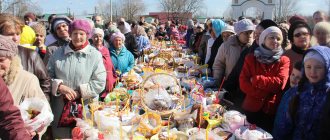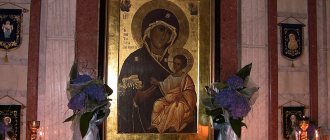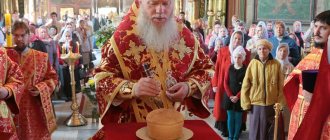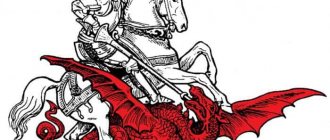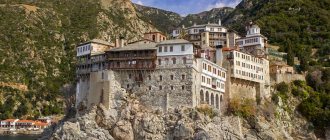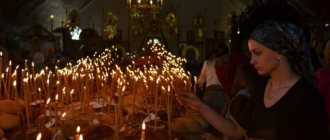Home > Useful tips > Easter in 2022: what date, date of holiday and traditions
Easter, the Holy Resurrection of Christ, is the most important Christian holiday. For believers, this is the victory of life over death or good over evil.
Easter Day is a moving event; in 2022, Orthodox Christians celebrate it on April 24, while Catholics celebrate it on April 17. The celebration was established in honor of the resurrection of Jesus Christ from the dead after the crucifixion. The event is the center of biblical history and the basis of Christianity.
According to the Apostle Paul, 1 Corinthians. 15:14
and if Christ is not risen, then our preaching is in vain, and your faith is in vain.
Why is Easter on different days every year?
The date of Easter is determined by the lunisolar calendar and is celebrated at a different time every year. The calculation method is called Paschalia, where the general rule is:
Easter is celebrated on the first Sunday after the spring full moon, which occurs no earlier than the spring equinox.
Both Paschals: the Alexandrian (Orthodox) according to the Julian calendar and the Gregorian (Catholic) according to the Gregorian calendar are based on this principle.
By full moon and equinox we do not mean astronomical phenomena, but calculated dates. The Easter full moon (day of the 14th moon) is taken from the lunar phase schedule calculated based on the Metonic cycle. The spring equinox, included in Easter, for the northern hemisphere is March 21.
For the Orthodox, the celebration falls between April 4 and May 8. The last time the earliest Easter was celebrated was in 2010, and the latest in 1983.
For Catholics and most Protestants, the date of Easter varies from March 25 (last in 1951) to April 25 (1943).
Periodically, all faiths celebrate the “Triumph of Celebrations” together, as was the case in 2022, and the next time will be in 2025.
March
- Baba Marta
is a cheerful holiday of the arrival of spring (celebrated on March 1). The custom of making martenitsa on this day is of ancient Thracian origin. The very first of them were red and white woolen threads, to which sometimes a gold or silver coin was also tied. Women made such martenitsa on the eve of the holiday. They were tied to outer clothing, belts, necks, legs, and arms. It is customary to wear martenitsa on the body for 3, 9 or 25 days. After this, they need to be removed and thrown into the river, hung on a green fruit tree in the yard, thrown onto the roof of the house or hidden under a stone. - National Liberation Day
(March 3). The anniversary of liberation from the Ottoman yoke is celebrated. On this memorable day in Bulgaria, the national flag is raised high, and wreaths are laid at the memorial of the Unknown Warrior in the capital (Sofia) in memory of the Bulgarians who died in the struggle for the liberation of the fatherland.
Easter dates by year from 2007 to 2028
| Year | Catholic Easter | Orthodox Easter |
| 2007 | April 8 | April 8 |
| 2008 | March 23 | April 27 |
| 2009 | 12th of April | April 19 |
| 2010 | April, 4 | April, 4 |
| 2011 | April 24 | April 24 |
| 2012 | April 8 | April 15 |
| 2013 | March 31 | 5 May |
| 2014 | 20 April | 20 April |
| 2015 | 5th of April | 12th of April |
| 2016 | March 27 | 1st of May |
| 2017 | April 16 | April 16 |
| 2018 | April 1 | April 8 |
| 2019 | April 21 | April 28 |
| 2020 | 12th of April | April 19 |
| 2021 | April, 4 | May 2 |
| 2022 | April 17 | April 24 |
| 2023 | April 9 | April 16 |
| 2024 | March 31 | 5 May |
| 2025 | 20 April | 20 April |
| 2026 | 5th of April | 12th of April |
| 2027 | March 28 | May 2 |
| 2028 | April 16 | April 16 |
May
- Labor Day
(May 1). As in many countries, this day is considered a holiday for all workers. - Day of Bravery and the Bulgarian Army
(celebrated on May 6). In Sofia, on the square in front of the Tomb of the Unknown Soldier, the president receives a ceremonial parade of a representative part of the large Bulgarian army. And half an hour after the patriarch of the Bulgarian Church consecrated the military banners, a military march of various military equipment starts. Also celebrated on this day is St. George's Day. - National Day of Slavic Culture and Literature
(May 24). This holiday is also called the Day of Saints Cyril and Methodius. This day is marked by festive processions of university and school teachers, scientists and schoolchildren who lay flowers at the monuments of the Slavic pioneer teachers.
Easter traditions
Most Easter traditions originate in worship.
Divine service
Since ancient times, in the Church at night, on the main holiday of the church year, divine services with Liturgy take place. In some countries (Serbia) it is performed at dawn - early in the morning.
Greetings
Starting from Easter night and throughout the next forty days, it is customary to “confess Christ” with the words “Christ is risen!” They respond to this greeting with “He is risen indeed!”
Holy Fire
The Easter or Holy Fire plays an important role in worship and symbolizes the “Light of God, enlightening all nations.” In churches of large cities they expect it from the Church of the Holy Sepulcher (Jerusalem Church of the Resurrection of Christ).
When the Holy Fire arrives, the priests carry it around the city’s churches, and Christians light their candles from it.
Catholics, before the start of the service, light a special Easter candle - Paschal. Fire from it is distributed to all Christians.
meal
On Holy Saturday, Easter cakes, Easter cottage cheese and Easter eggs prepared for the festive table are illuminated.
The Easter egg symbolizes the Holy Sepulcher. From the outside it looks dead, but inside there is new life.
The custom of giving eggs is associated with a legend according to which Mary Magdalene found a way to appear to Emperor Tiberius and give him a red-painted egg with the words “Christ is Risen!”
Another version of the presentation says that at first it was ordinary and the emperor doubted the news of the resurrection. He said, just as an egg cannot turn from white to red, so the dead do not rise again. The egg turned red before his eyes.
Despite the fact that eggs are painted in different colors, red is the traditional one, symbolizing the blood of the crucified Christ.
Procession
Before Easter, believers gather in a church, then at midnight a religious procession takes place around it or to the door of another with a large cross, icons and the singing of the stichera (prayer chants) of the holiday. When the procession approaches the doors of the temple, the service begins.
Easter bell
During Holy Week (the week preceding Easter), the bells are heard until Good Friday (Friday of Holy Week) inclusive. At the evening service, when they serve Matins on Holy Saturday, they also ring. After placing the Shroud in the temple, a peal is heard. Then the bells are silent until the Midnight Office (one of the services of the liturgical circle) of Holy Saturday (until the bell rings for the Easter service).
In other countries (France) there is also a tradition of keeping the bells silent from Good Friday until the celebration of the Resurrection of the Savior.
Varna
The date of the carnival in Varna changes every year, but it takes place on Saturdays. The first year when I arrived, in 2016 it took place on March 26, in 2022 - on April 29, IN THE CURRENT YEAR 2022, THE CARNIVAL IN VARNA WILL BE HELD ON APRIL 28. The official name of the Varna carnival is “Festival of masks, masquerade, stage and folk costumes.” (In Bulgarian: “Holiday for mask, masquerade and stage costume and folk wear”). It began to be held later than the carnival in Yambol, but now it competes with it. After watching the carnival in Varna a couple of times, I personally decided that it was enough for me, and I don’t need to go to Yambol or somewhere even further, it will be the same thing, the same costumes and masks. If only in Pernik, only because it is international there and the participants are not only from Bulgaria. Therefore, I will tell you in more detail about the Varna carnival. In previous years it started around 1 pm. Venue: the city center; in 2016 and 2022, the carnival took place on the square in front of the Cathedral of the Assumption of the Blessed Virgin Mary, the main square with the main cathedral of the city. A stage is set up near the cathedral, carnival participants parade through the square, after which the carnival procession continues from the square along Maria Louise Boulevard to the community of Varna, where they turn onto the pedestrian boulevard leading to the park. In 2022, the carnival stage was located on the square near the Opera House with a fountain, and then the carnival procession passed along the pedestrian boulevard of Prince Boris the First to the entrance to the park.
Before the start, participants gather in the square for about an hour and stand, during which time they can be clearly seen and photographed. Delegations from different regions, cities and villages from all over Bulgaria participate in the Varna Carnival, representing different traditions of costumes and masks from their areas. In the previous two years there were very few spectators, the area was quite empty. I was struck by the sharp difference in the holding of this carnival from any public holidays in Russia. Firstly, the difference in the size of the city and, accordingly, the number of spectators was felt very strongly. In Moscow, at all such events, such a crowd gathers that you won’t be able to push through anywhere and won’t see anything, unless you queue up several hours in advance. In addition, they would have brought in a bunch of police, blocked everything off, so you wouldn’t be able to go anywhere, you wouldn’t see anything, and you wouldn’t really be able to photograph anything. There were few people here, and everything was very free. I didn’t see the police at all, no one was blocking anything, you could move freely throughout the entire square, run around with a camera, come as close as you like to the carnival participants and take pictures of them (they posed with pleasure), no one chased anyone away or drove them away - it was simply a holiday for photographers, the likes of which photographers in Moscow have never dreamed of anywhere. You can easily photograph whatever you want. Everything was so calm, so free and fun, so different from our official demonstrations, when the approaches to Red Square are blocked off tens of kilometers away and all metro stations are closed - so that, God forbid, no one passes, and these official demonstrations take place with state flags and balloons , which I personally don’t even want to look at. Here in Europe everything is different, fun and relaxed. It is certainly interesting to look at the unusual fancy costumes and masks at least once.
carnival opening carnival hosts
In addition to traditional historical carnival costumes, which were worn at folk carnivals in Bulgaria in previous centuries, modern carnival and theatrical costumes are also presented at the Varna carnival - as a rule, participants in children's theater studios perform in them.
Folk costumes from different regions are also presented.
For those who have children, it is especially worthwhile to see the carnival, I think children will be especially interested - although adults too.
MORE PHOTOS OF THE CARNIVAL - IN THE VIDEO COLLAGE “CARNIVAL IN VARNA” VIDEO OF THE 2022 CARNIVAL
https://youtube.com/watch?v=92lVVxZdKgg
ALL ARTICLES ABOUT BULGARIA VIDEOS BULGARIA
Other articles:
“Russians in Bulgaria” “Tips for buying property in Bulgaria” “Sea resorts in Bulgaria” “Mineral resorts in Bulgaria” “Holidays in Bulgaria”, etc.
TOURS TO BULGARIA TOURS TO BULGARIA
What happened after the liberation of Bulgaria?
You should not think that after the liberation of Bulgaria, life in the country became cloudless and wonderful. As we already wrote in the essay on the history of the country, after the end of the war in 1878, the principality did not receive complete freedom. Moreover, part of the Bulgarian territories was lost, many of them, as it turned out later (and at a very high cost) - forever. But that was later. In the meantime, even such a reduced Bulgaria was divided into two halves: northern (the autonomous principality of Bulgaria itself) and southern (Eastern Rumelia, which was an autonomous province within the Ottoman Empire). Cities such as Burgas, Plovdiv, Pazardzhik, Stara Zagora, Haskovo, Sliven, Yambol found themselves outside the Bulgarian principality.
After the Treaty of Berlin, the area of Bulgaria was sharply reduced, and the remainder was divided in two. Immediately after the conclusion of the Treaty of Berlin, branches of the organization arose in many Bulgarian cities on both sides of the new border, which aimed at national unification. Numerous gymnastics clubs were opened, in which young Bulgarians allegedly played sports, but in fact, prepared for military action. In the spring of 1880, the international situation worsened, which provoked an action to reunite Eastern Rumelia with the Principality of Bulgaria. But diplomatic negotiations reached a dead end: Great Britain did not benefit from a strong Bulgaria, which was under the influence of Russia, and the Russian Empire did not want to spoil relations with the European powers. The politicians of Eastern Rumelia did not give up hope for reunification with Bulgaria, but waited for a more opportune moment, while simultaneously conducting propaganda among the population, organizing demonstrations and other events. They also held meetings with Alexander I, who promised to fully support the unification of the lost territories.




